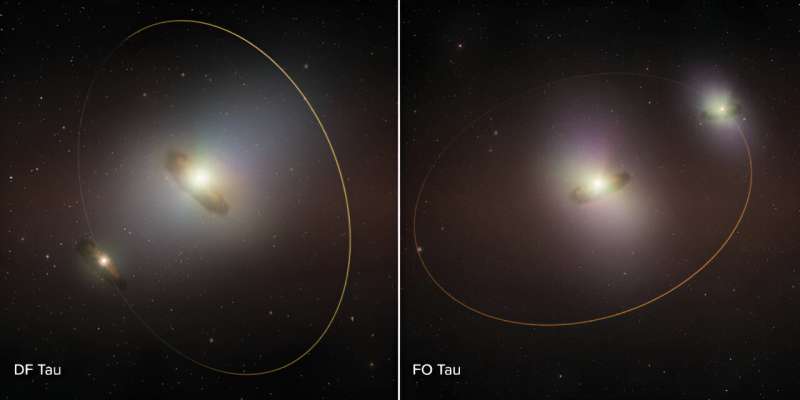This article has been reviewed according to Science X's editorial process and policies. Editors have highlighted the following attributes while ensuring the content's credibility:
fact-checked
trusted source
proofread
ALMA observations reveal new insights into planet formation in binary star systems

At the 244th meeting of the American Astronomical Society (AAS), researchers unveiled findings from a pioneering high-angular resolution program that sheds new light on the process of planet formation in circumstellar disks around young stars in binary systems.
Leveraging the unparalleled capabilities of the Atacama Large Millimeter/submillimeter Array (ALMA) and near-infrared, component-resolved spectroscopy at the Keck II 10-meter telescope, the study offers a transformative understanding of the conditions that nurture or inhibit planet formation.
Primordial disks of gas and dust around young stars have long been recognized as the sites of planet formation. However, the conditions that ensure disk lifetimes adequate for planet formation, and the triggers that lead to their early disk dissipation, have remained elusive. Circumstellar disks in pre-main sequence binary systems provide a unique and ideal laboratory to explore these questions.
By analyzing disk properties—such as size, substructure, and inclination—in relation to stellar characteristics like rotation speed and magnetic field strength, researchers are beginning to decode the complex interplay that governs these stellar environments. Binary and multiple star systems are extremely common, underscoring the significance of their study.
This innovative research combines millimeter imaging of circumstellar disks with ALMA and high-resolution spectroscopy of young stars using Keck with the NIRSPEC spectrometer. By focusing on binaries with relatively well-determined orbits, the team can control for orbital parameters and highlight critical relationships between the properties of circumstellar disks and their host stars.
The study's detailed examination of the DF Tau binary, quasi-twin stars with an average separation of 14 astronomical units (where 1 au equals the Earth-sun distance) in an elongated orbit, reveals cool dust in two circumstellar disks detected by ALMA.
One disk is magnetically locked to its central star and is actively accreting material onto the star, while the inner region of the other disk appears to have eroded and decoupled from its rapidly rotating central star, suggesting a potential link between stellar rotation, magnetic disk locking, and early disk dissipation. Misalignments between DF Tau's orbit, circumstellar disks, and stellar inclinations may impact the disk evolution.
In contrast, another young star twin, FO Tau, a 22 au binary in a more circular orbit, displays ALMA-detected disks well-aligned with the binary orbit. Both components exhibit modest rotation speeds and appear to be magnetically locked to their disks. These observations reveal similar behavior in both disks and stars, providing fresh insights into the dynamics of disk longevity and dissipation.
High-angular resolution observations from ALMA have shown intricate disk sub-structures, including spiral patterns, gaps, and ring formations around single stars and wide binary companions. Although disk substructures are as yet unresolved in DF Tau and FO Tau, the ability to determine bulk disk properties in close binary systems marks a significant advance in our understanding of planet formation environments.
This research reveals unique progress in the field of astronomy. The insights gained not only enhance the comprehension of circumstellar disk dynamics but also pave the way for future discoveries in the mechanisms of planet formation.
Provided by National Radio Astronomy Observatory




















